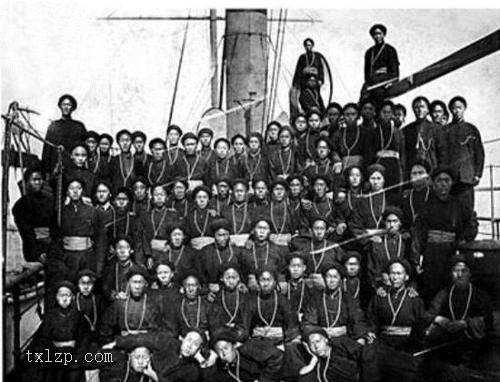Period:Unknown Production date:6thC-7thC
Materials:stucco, 灰泥 (Chinese),
Technique:mould-made, 模製 (Chinese), slipped, painted,
Subjects:bodhisattva (?) deity 菩薩 (Chinese) 神 (Chinese)
Dimensions:Height: 22.80 centimetres
Description:
Part of a stucco figure. This is the head of a male deity, possibly a bodhisattva, with a serene expression. The eyes have hollow pupils, probably originally inlaid with glass or stone. The hair is brushed up from the forehead and drawn loosely back under a fillet made of alternating plain and beaded bands. The topknot is missing. Traces of a white slip as well as a yellow and red paint can still be seen.
IMG
![图片[1]-figure; 畫像(Chinese) BM-MAS.1094-China Archive](https://chinaarchive.net/Unknown/43/mid_01144340_001.jpg)
![图片[2]-figure; 畫像(Chinese) BM-MAS.1094-China Archive](https://chinaarchive.net/Unknown/43/mid_01144347_001.jpg)
![图片[3]-figure; 畫像(Chinese) BM-MAS.1094-China Archive](https://chinaarchive.net/Unknown/43/mid_01144349_001.jpg)
![图片[4]-figure; 畫像(Chinese) BM-MAS.1094-China Archive](https://chinaarchive.net/Unknown/43/mid_01144336_001.jpg)
![图片[5]-figure; 畫像(Chinese) BM-MAS.1094-China Archive](https://chinaarchive.net/Unknown/43/mid_00012983_001.jpg)
![图片[6]-figure; 畫像(Chinese) BM-MAS.1094-China Archive](https://chinaarchive.net/Unknown/43/mid_00236213_001.jpg)
Comments:EnglishFrom Whitfield 1985:This well-moulded head, almost life-size and with sharply defined features, was one of a number (see also Fig. 134) found in a shrine slightly apart from the rest and raised on a high-walled terrace, whose brickwork was strengthened with layers of reeds. The interior of the shrine was completely filled with hard-burned debris, and Stein only had time to effect a partial clearance around the entrance. No trace was found of the bodies belonging to this or to other similar heads, all close in style to those found in nearby ruins (x-xii). Stein’s explanation was that the bodies were insufficiently fired in the conflagration that destroyed the temple, but another observation should perhaps be made here. Although reports from other sites (cf. Toumchouq, 1964, Vol. Ⅱ, p. 142) confirm that the material used was generally clay mixed with some fibre, it seems probable that the heads, moulded and fashioned separately, could have been hardened in the open, before being fitted to the bodies which, being necessarily modelled in situ, remained softer and more vulnerable. This might account for the preservation of so many finely detailed heads. As noted in the description of the tile seen in Pl. 112, Stein himself ventured the possibility of an actual firing of some pieces, besides the hardening and loss of colour during the destruction of the shrines. ChineseFrom Whitfield 1985:此用模子製造精良,極具特徵,約等同真人大的佛頭,是從距其他寺址較遠,用槁草加固磚堆的高臺地上的一個殿堂中發現的大量遺物中的一件(Fig.134圖)。殿堂的內部被燒成的硬物掩埋,斯坦因爲清理入口附近不得不花費相當長的時間。包括此佛頭在內,本址發現的几个頭像,在風格上與鄰近的x~xii遺迹發現的遺物極接近,而有關這些頭部的身軀,則毫無線索。斯坦因認爲,軀體毀於寺院這場大火,關於此事也許還需要另外的考察。在有關另一遺迹的考察報告(參照《Toumchouq》1964年,第2卷142頁)中,確認在泥土裏通常摻雜纖維。推測頭部與身軀是分別用模子製作,臉部在整理安裝在身軀上之前,在戶外被曬乾變硬。與此相比,軀體則必須在原位置上製作,堅固性差,處在容易損壞的狀態。從這種情況考慮,非常多的保持住精美細部的頭部被保留了下來,是說得通的。如圖112的磚的解說中提到的,斯坦因對許多作品都做過嘗試性的論述,由於佛堂的火災而變得堅固化及色彩喪失之前,作品某些部件要進行燒煉。
Materials:stucco, 灰泥 (Chinese),
Technique:mould-made, 模製 (Chinese), slipped, painted,
Subjects:bodhisattva (?) deity 菩薩 (Chinese) 神 (Chinese)
Dimensions:Height: 22.80 centimetres
Description:
Part of a stucco figure. This is the head of a male deity, possibly a bodhisattva, with a serene expression. The eyes have hollow pupils, probably originally inlaid with glass or stone. The hair is brushed up from the forehead and drawn loosely back under a fillet made of alternating plain and beaded bands. The topknot is missing. Traces of a white slip as well as a yellow and red paint can still be seen.
IMG
![图片[1]-figure; 畫像(Chinese) BM-MAS.1094-China Archive](https://chinaarchive.net/Unknown/43/mid_01144340_001.jpg)
![图片[2]-figure; 畫像(Chinese) BM-MAS.1094-China Archive](https://chinaarchive.net/Unknown/43/mid_01144347_001.jpg)
![图片[3]-figure; 畫像(Chinese) BM-MAS.1094-China Archive](https://chinaarchive.net/Unknown/43/mid_01144349_001.jpg)
![图片[4]-figure; 畫像(Chinese) BM-MAS.1094-China Archive](https://chinaarchive.net/Unknown/43/mid_01144336_001.jpg)
![图片[5]-figure; 畫像(Chinese) BM-MAS.1094-China Archive](https://chinaarchive.net/Unknown/43/mid_00012983_001.jpg)
![图片[6]-figure; 畫像(Chinese) BM-MAS.1094-China Archive](https://chinaarchive.net/Unknown/43/mid_00236213_001.jpg)
Comments:EnglishFrom Whitfield 1985:This well-moulded head, almost life-size and with sharply defined features, was one of a number (see also Fig. 134) found in a shrine slightly apart from the rest and raised on a high-walled terrace, whose brickwork was strengthened with layers of reeds. The interior of the shrine was completely filled with hard-burned debris, and Stein only had time to effect a partial clearance around the entrance. No trace was found of the bodies belonging to this or to other similar heads, all close in style to those found in nearby ruins (x-xii). Stein’s explanation was that the bodies were insufficiently fired in the conflagration that destroyed the temple, but another observation should perhaps be made here. Although reports from other sites (cf. Toumchouq, 1964, Vol. Ⅱ, p. 142) confirm that the material used was generally clay mixed with some fibre, it seems probable that the heads, moulded and fashioned separately, could have been hardened in the open, before being fitted to the bodies which, being necessarily modelled in situ, remained softer and more vulnerable. This might account for the preservation of so many finely detailed heads. As noted in the description of the tile seen in Pl. 112, Stein himself ventured the possibility of an actual firing of some pieces, besides the hardening and loss of colour during the destruction of the shrines. ChineseFrom Whitfield 1985:此用模子製造精良,極具特徵,約等同真人大的佛頭,是從距其他寺址較遠,用槁草加固磚堆的高臺地上的一個殿堂中發現的大量遺物中的一件(Fig.134圖)。殿堂的內部被燒成的硬物掩埋,斯坦因爲清理入口附近不得不花費相當長的時間。包括此佛頭在內,本址發現的几个頭像,在風格上與鄰近的x~xii遺迹發現的遺物極接近,而有關這些頭部的身軀,則毫無線索。斯坦因認爲,軀體毀於寺院這場大火,關於此事也許還需要另外的考察。在有關另一遺迹的考察報告(參照《Toumchouq》1964年,第2卷142頁)中,確認在泥土裏通常摻雜纖維。推測頭部與身軀是分別用模子製作,臉部在整理安裝在身軀上之前,在戶外被曬乾變硬。與此相比,軀體則必須在原位置上製作,堅固性差,處在容易損壞的狀態。從這種情況考慮,非常多的保持住精美細部的頭部被保留了下來,是說得通的。如圖112的磚的解說中提到的,斯坦因對許多作品都做過嘗試性的論述,由於佛堂的火災而變得堅固化及色彩喪失之前,作品某些部件要進行燒煉。
© Copyright
The copyright of the article belongs to the author, please keep the original link for reprinting.
THE END



![[Qing Dynasty] British female painter—Elizabeth Keith, using woodblock prints to record China from the late Qing Dynasty to the early Republic of China—1915-China Archive](https://chinaarchive.net/wp-content/uploads/2022/11/image-191x300.png)

